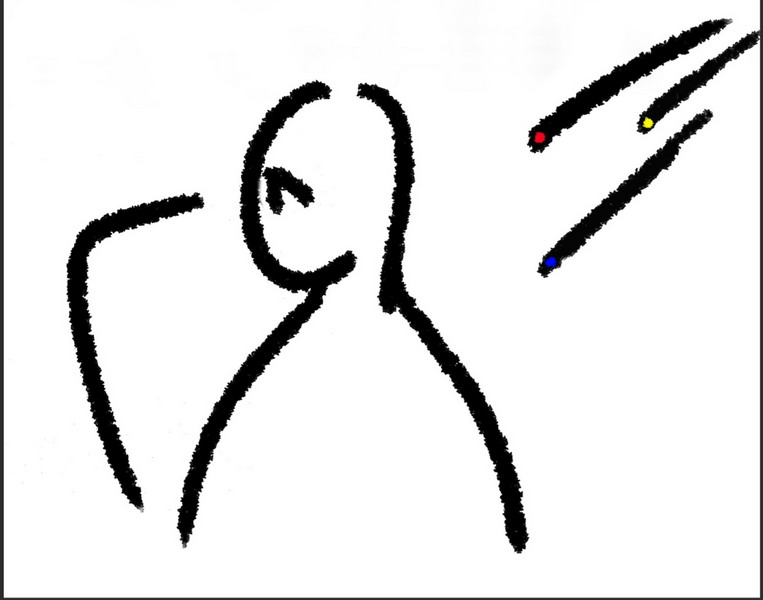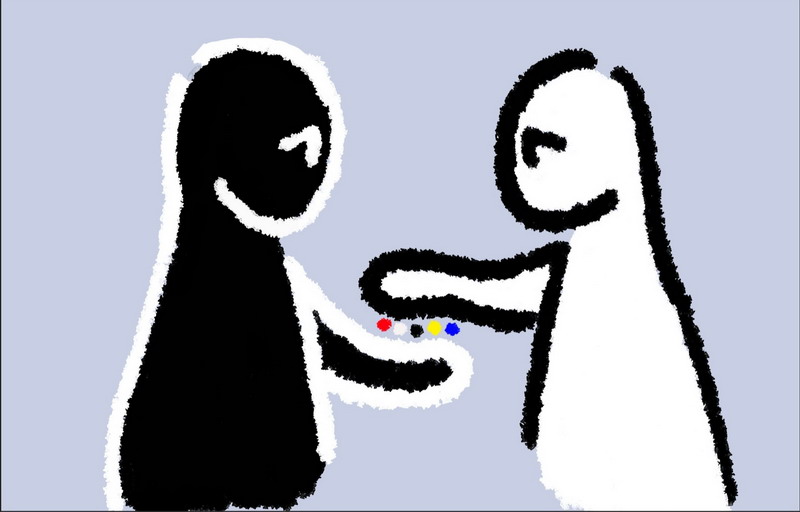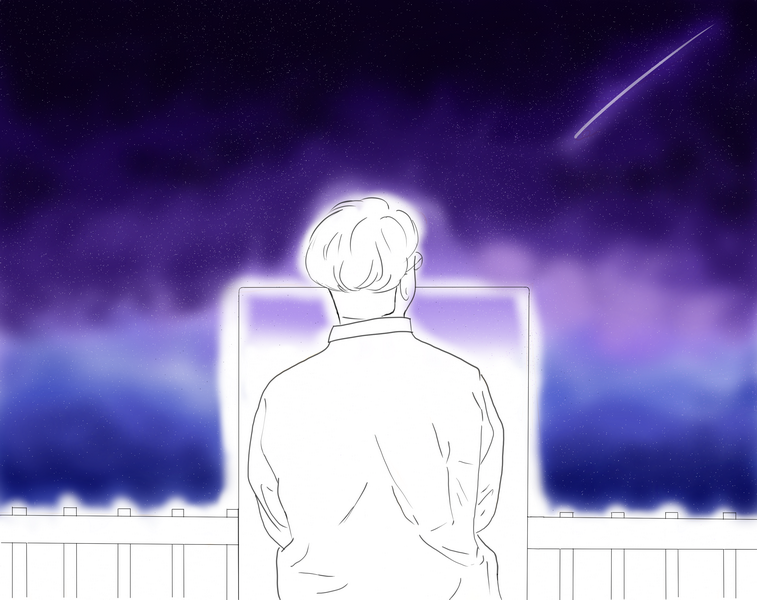The Man Who Owned Red
By Grace Ryoo
The man’s name was Ryan. Ryan Edrund.
He had a thin face, untidy hair, and thick glasses. But he had a rather nice smile, and he would sometimes give out treats to the children who passed by his house.
The man was an artist. He would sometimes grab his pencils and sketch and paint quickly in an attempt to capture the everyday lives of the people around him. He never sold many of his paintings, but he would often claim that his goal was not recognition or reward.
The neighborhood that he lived in was like him, plain but warm. But the most important characteristic of this little town was that it was white. Almost everything was white – the grass, the houses, the roads – in fact, the only black colors occasionally seen were the hairs of people who had not yet dyed their hair white. The artist was no exception. His white clothes were often stained with white paint. But unlike the other villagers, he had traveled often when he was a boy. He had been to many places, to the capital of his chalk-white country, to the milky white cities around it, and even to the edges of the nation he called home. It was there where he had first seen a black man.
The black man looked exactly the opposite of the white people the man had seen. He had obsidian, licorice-black skin and clothes that the man quoted later as being “made of black flowing fabric that rippled in the wind. It was beautiful, but for me, it was also the strangest clothing I’d ever seen.” While the artist was not the kind of person who would judge people quickly, the black man somehow seemed, well, wrong. In fact, the only factor that seemed right to him was the black man’s hair, which was snowy white. It was a weird and unpleasant feeling, to judge someone before even knowing them.
The man learned later that he was not alone in feeling this way. This was how many people felt towards others who had a different color. He read books about black people, and according to the tales of the past, they had once lived with white people, and white people had also lived in the cities of the black people. It, however, led to trouble. Although the two peoples were very much similar to each other, just the fact that one man had white pigmented skin and the other black seemed to be the cause of diverse forms of discrimination. The man wondered why the simple fact that their colors were different had such a strong impact on them. Maybe it was because in a world where there was only white and black, it was hard for a person of one color to ignore their clear differences. Or maybe it was because white people had always thought of black as the “other” color and one that needed to be tailored to become white. They might have unconsciously believed that the ideal image was white, while black was seen as an opposition, and the blacks might have thought conversely. The man realized that, ironically, because people tried to compare one color to the other, arguing that one was better instead of realizing their differences, conflicts emerged. If they had realized that they were on equal terms, and had acknowledged that other people were just different and not to be feared, the level of conflict would not have grown to one that resulted in a division of countries. According to the old stories, the two groups of people found it increasingly difficult to live together, and so they separated and did not come back. It had been like this for about a hundred years, and the people eventually forgot about each other, and except for a few unexpected meetings at the border, they did not see each other.

But now it was the present. The artist was sitting on his sofa drinking a cup of warm, white tea before he got ready to go to bed. He looked out of the window at his garden and took a sip of tea. He then looked back out the window, and this was when he saw it for the first time.
Something was streaking across the sky. It was blazing with light and heading straight for his house. The artist sat, frozen, as it came closer and closer gathering speed, and at last, it became a ball of fire that landed with, quite strangely, a soft plop in his garden. The man sat in his chair for a full five minutes before shakily getting up, not believing what had happened, and going out to his garden. The meteorite was sitting among his lilies, seeming oblivious to the shock it had caused. The man, after poking it with a stick and finding it surprisingly cool, picked it up and took it inside. At first glance, it looked like a piece of solid rock, but turning it around, he found a crack. Curious, he carefully cracked it open.
Inside, there was a crystal of a color he had not ever seen before. It was a blazing, passionate color. It was bright like the white he had often seen, but it had a radiance to it that was different from white. It almost hurt his eyes to look at it, but he could not take his eyes off the crystal, realizing that he had found a new color, one that no one had known before.
He decided to name it “red,” after his name.
After a few months, the artist was not just an artist. He was the man who had discovered a new color, the man who owned red. After he found that the crystal produced a red pigment when put in the sun, people from all over the country came to look at his paintings, now filled with splashes of white and red. There were also hundreds who asked for the usage of the color for clothes, paper, pictures, and anything you could color. It was a tremendously popular discovery. Although it was soon found that red could not be covered up with white when you made a mistake coloring, it was still a sensation.
A few months later, as if it had been planned beforehand, news was heard that two new colors were found in the county of the black people. This was the first time many people from the white country had heard news from the black country, and it made waves of curiosity about what the two colors were.
The man was called upon to negotiate with the black people. The idea was to offer a trade: They would give some of the colors red and white to the black people and get the new colors, which were named “blue” and “yellow.” It would be the first official meeting between the two countries in a hundred years.

The man stood inside a building on the plains, looking out at the border. The scenery was a sudden change, like someone had drawn a line and colored one side white and the other black. Two black people were coming toward him from the black side, dressed in billowing robes, and each held in their hands a bottle full of pigments of the beautiful new colors. Formal greetings were shared, treaties were signed, and the colors were exchanged. Everything went carefully in order.
When it was all done, the man expressed his thanks and went to leave. The black men, however, asked him to wait and gave him a bottle full of the color black. One black man looked at the artist and said, “We are gifting this to the white people in the belief that it would not be a color that opposes white anymore, but a color that can add to the diversity of your palates. We believe it would be an important color as well, for we know that it is the only color that can fully encompass another color and cover up coloring mistakes. This is similar to how we think white will be the only color that can mingle with another without losing that color’s characteristic, and be able to create lighter versions of each hue.”
The man looked at the black man, and at once he understood that the harmony of the two colors black and white was a key to the potential of the new colors, a key to the development of all the colors together as one. Black and white should not be forced to adhere to each other’s rules; rather, each should be respected as it is. They needed each other. If their world were to undergo an amazing development with the discovery of the new colors, the blacks and whites would have to work together. Neither people could achieve this goal on their own.
A few years later, the world was a very different place. With the colors red, blue, and yellow, along with the colors black and white, a greatly diverse discovery of colors followed. And the world was soon filled with sensations of new colors. The man, however, remained the same as before, before the day he had made the discovery that would change his life. He was outside in his garden, sitting on his chair bathing in warm sunlight, adding paint to his sketches. A neighborhood boy walked up to him. He asked with curiosity what the man was drawing. The man looked up, and with a twinkle of a smile, he answered that he was drawing how beautiful the world could be when everyone and every color was harmonized and respected as they were. The boy cocked his head to the side and walked over to the other side of the artist’s canvas to see what he was painting. In the middle of the canvas, donned with brilliant colors and bridging between two clouds, was a rainbow.
Graphics by Grace Ryoo.
The Author
Grace (Yeonwoo) Ryoo is a college freshman majoring in global affairs. She volunteered to translate articles for the GIC for three years in high school. She likes to read, draw, write, and take pictures in her spare time. She also likes to imagine and look at the world from a different point of view. Instagram @grace_ryoo





